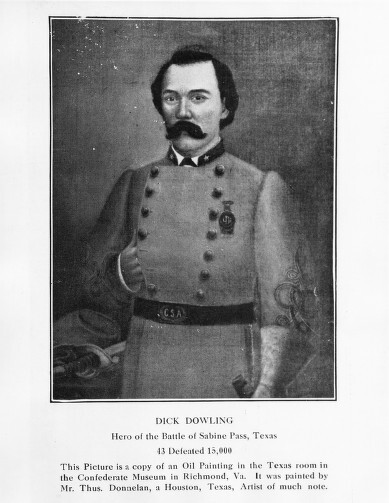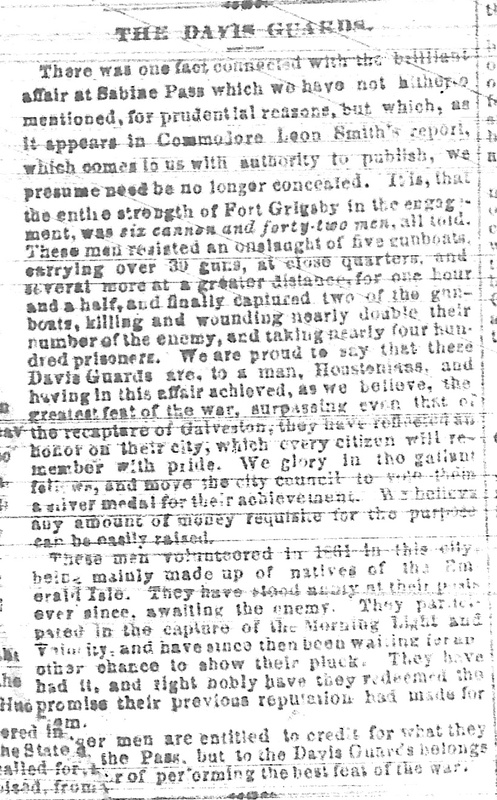Battle Of Sabine Pass Significance

Painted Portrait of Dick Dowling by Thurston Donnellan Representating him as a Solider
Immediately after the Battle of Sabine Laissez passer, Dick Dowling and his Davis Baby-sit became legendary among Confederates for their war machine achievement, which had prevented federal troops from occupying Texas. Due to the significance of the battle for the Confederacy, Dowling and his men received a great deal of praise and recognition, especially from Texans and fellow Houstonians, who could boast a local connection to the victory. The stories these early admirers told laid the groundwork for after attempts to commemorate Dowling, both in what they emphasized—his unlikely victory—and in what they elided from the story.
Some of the initial stories well-nigh Dowling's victory at Sabine Pass highlighted the Irish heritage of the Davis Baby-sit and its commander, but most contemporary accounts of the boxing focused on the odds that Dowling faced and the service he provided to the Confederacy. For example, an 1863 note from Leon Smith describing the battle reads, "God anoint the Davis Guards, 1 and all! The honor of the country was in their hands, and nobly they sustained it." The women of Sabine City presented a flag to the Davis Guard, and Charles Otis fifty-fifty proposed that a concert be held for Dowling and his men to commemorate their valiant armed forces efforts (Items 538, 463). Within days of the battle, contemporaries already compared information technology to the Battle of Thermopylae, the famous stand of the 300 Spartens confronting the invading Persians. Early in 1864, the Confederate Congress passed a resolution which included, among other costless language, the annunciation that "this defence force . . . constitutes, in the stance of Congress, one of the most bright and heroic achievements in the history of this war." At the proposition of Jefferson Davis himself, the soldiers too received silverish medals with light-green ribbons that had "D.G." (for Davis Guards) engraved on one side and "Sabine Laissez passer, Sept. viii, 1863" on the other. (Click hither for an image of one of the surviving medals.)
In the succeeding decades after the boxing, virtually stories about Dick Dowling continued in this vein, turning him into a legendary Confederate war hero who unmarried-handedly saved Texas from destruction by Yankee forces. His obituary in 1867, after his death from yellow fever, lauded his "unparalleled boldness and intrepidity" and praised him equally a "warm-hearted hero" for his activity at the Battle of Sabine Pass, only did not include his style of death or his accomplishments in the city of Houston (Item 336). Instead, the obituary spent four paragraphs detailing the battle, while only i sentence focused on Dowling himself, demonstrating the centrality of his war hero image in the public agreement of Dowling's persona.

Houston Newspaper Response to the Battle of Sabine Pass, Focus on "Pluck" and Military Skill
In the xxx years later Dowling's expiry, stories about the boxing and the Davis Guards'southward heroism continued to spread, taking on mythic proportions. The boxing was referred to as "the greatest feat of the war, surpassing fifty-fifty that of the recapture of Galveston," by theHouston Tri-Weekly Telegraph (Particular 464). Equally time passed, the number of Matrimony soldiers and prisoners in the battle was also increasingly exaggerated every bit a ways of glorifying the Confederacy. Initially, local newspapers claimed that the Davis Guard had taken around 235 prisoners. About a week later on, the number of prisoners captured had "increased" to 400. In 1867, the number of attacking soldiers was supposedly xv,000 men, simply a few decades afterward various sources quoted the numbers as x,000 and 20,000. This disparity in the statistics indicates the prevailing tendency of Amalgamated sympathizers to focus on the victory as an example of Amalgamated heroism.
The Battle of Sabine Pass was specially historic in an 1882 speech by Jefferson Davis, which called Sabine Pass the Confederacy's Thermopylae. In his exaggerated retelling of the boxing, Davis described an "iron clad fleet [that] came steaming upwards the river with nothing to oppose it but a mud fort armed with field guns and held by 42 men." The fleet actually independent no ironclad ships, and the fort Dowling defended was not a simple "mud" shelter, simply Davis used this account to stress the bravery of Dowling, who supposedly told his men, "Nosotros volition fight to the death!" (Item 453). According to Davis, Dowling was an even more than successful commander than the Spartan leader Leonidas because Dowling'southward forces were victorious without suffering any casualties.
Told in this way, Dowling's story fit easily into the mythology of the "Lost Cause," which was first adult by Southern historians and former Confederate leaders such every bit Jefferson Davis and Robert Due east. Lee in the backwash of Reconstruction and was later taken upwards by groups such every bit the United Confederate Veterans. The Lost Cause referred to the idea that the South was never capable of winning the Civil War because the North had an overwhelming advantage due to their increased resource and manpower. According to the Lost Cause, Southern soldiers never would have been able to defeat the Northern forces no matter how bravely and nobly they fought, and were therefore fighting a "Lost Crusade." Lost Cause historians and writers besides denied that slavery was a crusade of the Civil War, arguing instead that courageous white Southerners were simply defending their homes from Northern aggression.
The early versions of the story of Dowling and the Battle of Sabine Pass certainly supported these Lost Cause ideas. Every bit remembered in the immediate aftermath of the boxing, Dowling'south life offered a perfect example of guileless Confederate heroism and the Union's overpowering corporeality of resources. Although stories about Dowling were less prevalent between 1867 and 1882 than before or later, the thought of the Lost Cause established a powerful narrative that helped ensure the revival of his retentiveness in the 1880s.
Revised June sixteen, 2020
Battle Of Sabine Pass Significance,
Source: https://digitalprojects.rice.edu/wrc/dick-dowling/exhibits/show/dick-dowling/afterlives-of-dick-dowling/2
Posted by: mattinglyhouggettere.blogspot.com


0 Response to "Battle Of Sabine Pass Significance"
Post a Comment